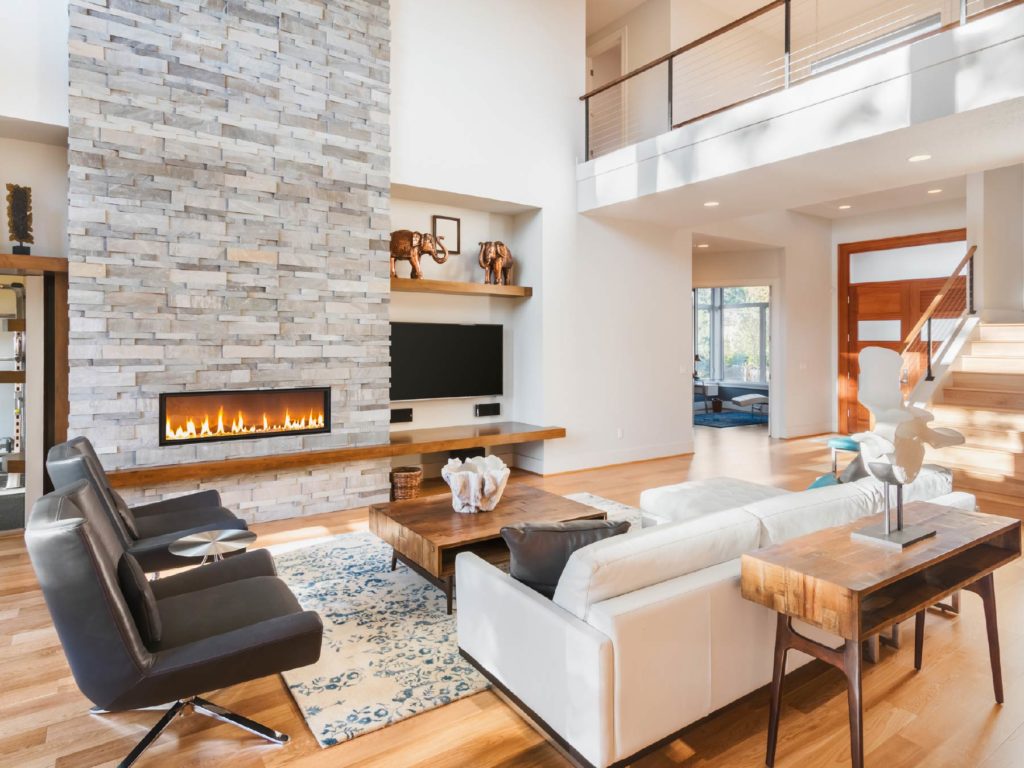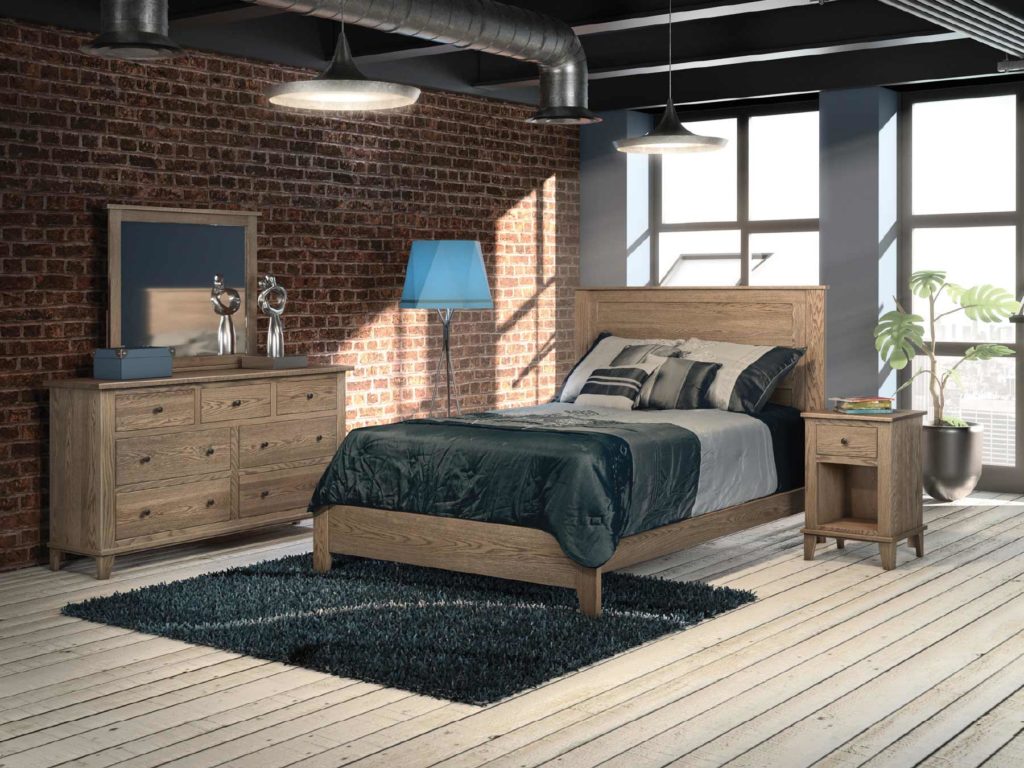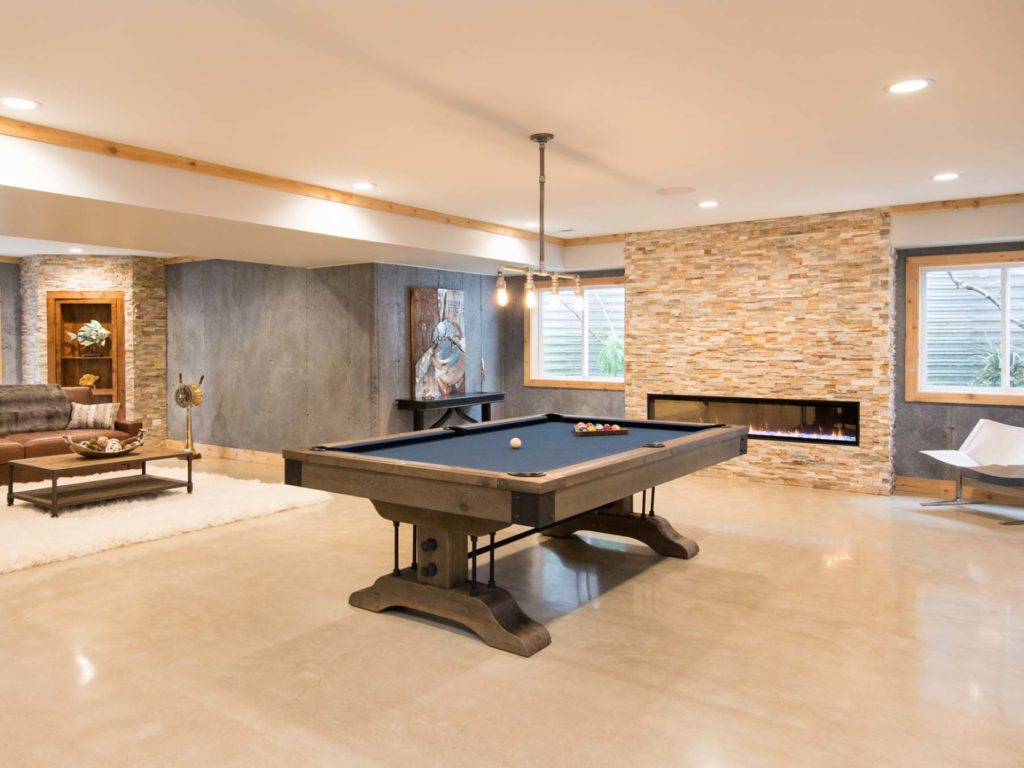Looking to refresh your home with a touch of something new? You’re in luck. These easy steps can make a big difference in how you use your home.

Spring is a time for renewal and rejuvenation, not just for us but also for our homes. Now that winter is in the rearview, it’s time to pack up our parkas and snow boots and get ready to welcome warm weather. Why not take this time to give your home a little change as well?
From sprucing up furnishings and splashing color on your home’s exterior to giving your living space a major facelift, here are a few ways that you can add a bit of spring to your home’s step and set the tone for warmer months to come.

Freshen up Your Furnishings
Sometimes, something as simple as upgrading your furniture can make a huge difference in how you interact with a room. Your furniture is more than just a functional way to rest, relax and store items. It’s also an important extension of your home’s, and your, personality.
So, if you’re going to update your furniture it’s a good idea to make sure you do it right the first time. There is a significant difference between well-built furniture and the cheaply made goods available at many a big-box retailer.
“I like to sell furniture that you buy once,” says Bob Wozniak, owner of Strode’s Furniture, 11707 Main St. in Huntley. “Our furniture is built to last for as long as you want to hold onto it.”
Strode’s Furniture has been providing high-quality, American-made furniture since 1976. A fixture of Huntley’s downtown, the store is a favorite with customers because of its high-quality wares.
Those customers also tend to appreciate the knowledgeable salespeople who are always on hand to explain the difference in quality and help customers to find something that fits their personal aesthetic.
“The first thing I ask when a customer walks in is whether or not they’re looking for solid wood,” chuckles Wozniak. “If they’re not, they might be in the wrong store.”
While quality pieces come in a wide variety of styles and sizes in the showroom, customers are also invited to order something that’s more to their liking. It typically costs more than the one-size-fits-all options at the big-box store, but custom furniture allows you to have it your way, with the colors you like and the size that you need – and to a standard that’s built to last.
Wozniak and his team have a partnership with the Amish of northern Indiana that allows customers to mix and match wood species, stain and size on a variety of pieces, from dining room tables to bedroom sets. The result is a one-of-a-kind piece for the home.
“I have about 50 Amish shops that I work with,” says Wozniak. “If they get an order for a custom set made from a certain type of wood, they’ll make it. If you just want something small, like a nightstand, they’ll make it.”
These Amish workshops can also fit a number of eras and styles.
“A lot of the stuff they make has a more modern look,” says Wozniak. “They make a lot of furniture in the Shaker style, with a cottage-style look to them. There’s something for everybody.”
Strode’s also carries a wide variety of other furniture, particularly sofas and home decor that’s built in America. Many of these options also come with customizable upholstery and other features.
If you’re thinking about buying custom furniture, or even buying something from the showroom, it’s always a good idea to provide sizes and styles you like, to help staff zero in on the best options. A professional salesperson will ask lots of questions and answer the customer’s questions, too.
“We like to take the time with everyone, especially if they’re coming in to see us for the first time,” says Wozniak.
The final step is delivery, and most furniture stores will bring your new furniture right to your door. At Strode’s, all merchandise is carefully inspected before heading to its destination. The store offers free delivery within the Chicago area.
“Nothing goes out of our store or off our delivery truck without someone inspecting it,” says Wozniak.

Don’t Just Paint Your Home, Shield It
Painting your house is one of the least fun, but most necessary chores in home ownership. A properly painted home not only looks appealing but it’s also protected from the harsh winds, rains and winters that blow through the Midwest. Countless homeowners have stared forlornly at their half-painted homes wishing there was a way to put off this onerous chore forever.
There is an option, and while it may not last for all of eternity, it has managed to make dreams come true for at least a quarter of a century.
Rhino Shield of Chicagoland is more than just house paint. This company offers a revolutionary coating system, made of high-performance ceramic coating, that offers protection and durability beyond anything poured out of a paint can.
“Rhino Shield can go on any type of exterior,” says Zach Dixson, a Rhino Shield of Chicagoland sales representative. “It’s a system that coats the exterior of your home for up to 25 years.”
Using an elastomeric exterior paint coating that is environmentally safe, vapor permeable and comprised of about 40% less water than traditional house paint, Rhino Shield of Chicagoland has been providing long-lasting, maintenance-free coatings for residential and commercial exteriors since 2004. The product can provide a maintenance-free finish to all common siding materials, including cedar, cedar shake, aluminum, vinyl, stucco and Tudor surfaces. There’s no limit when it comes to choosing a color.
“We have every color of the rainbow,” says Dixson. “You can even bring in a sample of the color you want. We’ll match it.”
While Rhino Shield’s longevity may be its greatest advantage, there are other factors that make it a solid choice for someone looking to liven up their home’s exterior. One advantage is the savings. Even homeowners who do the painting themselves will save the cost of the paint, tools and supplies that go into doing it every five years – which is about the average longevity of a standard house paint, says Dixson.
Rhino Shield is also made in a way that saves energy costs because it does a better job of reflecting heat, adds Dixson. It’s Class A fire resistant, UV-resistant and abrasive-resistant, and it stays free of mold, mildew and water stains.
“A lot of our customers garden, live by a body of water or have water runoff from their gutters,” says Dixson. “Our product prevents those nasty green molds that can grow as a result.”
The best part is that you’re not stuck on a ladder or scaffolding, doing the job yourself. Rhino Shield’s thick, elastic coating is sprayed, rolled and painted on by a professional crew in the same amount of time as a traditional paint job. And, should you decide to move to a new home, Rhino Shield of Chicagoland will pass on your warranty to the next family that buys your home.
“The best part about Rhino Shield is that it’s a one-and-done system,” says Dixson.

Roll Up Your Sleeves and Renovate
There are times when rejuvenation means major change, like completely renovating a room in your home or even constructing a whole new addition. After all, your home is your castle and the best way to enjoy it is to make sure every room is set up in a way that makes you want to stay in it. A typical home also tends to have areas where you don’t spend a lot of time, simply because you wouldn’t want to. So, why not fix them up and enjoy them?
Perhaps the best place to begin is with a design and remodeling specialist who can oversee the work from start to finish.
“The remodeling world can be a crazy place, and a lot of people have no idea where to start,” says Chris Low, a lead project designer with Advance Design Studio, 30 Railroad St. in Gilberts. “We try and cross out all the unknowns and put a process in place that’s the same, no matter what size the project is. We want to put the client first, answer their questions, and make sure that everything we do is clean and simple with no hidden surprises.”
If you’re thinking about embarking on a major renovation, talking with a qualified designer can help to suss out your needs and your vision. If you don’t have either at first, don’t worry.
“Often, instead of asking what you like, I’ll ask what you don’t like about the current space,” says Low. “That gives me an idea of how the space should be organized and laid out. It gives me a feel of what you want us to improve upon.”
While you’re looking for things to improve, you may also want to take a closer look at those rooms and spaces you barely use. Ask yourself why you aren’t using this space and what kind of changes could make you want to use it. Again, if you’re high on desire but short on ideas, a designer can help.
One room where Low has seen an uptick in interest is the basement. As an area of the home that’s often underutilized, lower levels are often just a place for storage and laundry. Turning this area into a functional and stylish space adds to your home’s work, play and living spaces, but it also adds resale value.
“Renovating your unfinished basement can provide hundreds, sometimes thousands, of square feet to the usable space in your home,” says Low. “You can have a beautiful new room that previously wasn’t being used for anything but storage.”
Low has seen clients transform a vacant basement into funky, fun family gathering spaces like personal gyms and home cinemas. One family in Barrington installed a secret entrance and converted a corner of their partially finished basement into a secret speakeasy.
Even if you decide not to be highly original, there are plenty of opportunities to provide something that’s nonetheless functional and personal.
“A lot of our clients add bathrooms to their basement, which can really turn it into a useful space,” says Low. “We’ve also had clients who want to add kitchenettes.”
A finished basement also adds personality, giving homeowners a place that’s specifically their own for hobbies – think sewing rooms and wood shops – or a place to hang out with a television or some gaming tables.
“With upstairs rooms, like kitchens and bathrooms, people tend to play it safe,” says Low, “but in the basement, they really make the room their own with different colors and flair.”
Another underused and under-considered space is your home’s exterior footprint. Low sees a lot of clients who add living spaces beyond the walls of their home in a way that also increases their enjoyment of the outdoors.
“I think that a three-season outdoor addition is a great place to start,” says Low. “Adding a sunroom, for example, gives you plenty of extra space and a lot of opportunities to enjoy the sunshine. And if you opt for vinyl windows, as opposed to screens, you lengthen the amount of time to enjoy the room. You get a cozy indoor space while, at the same time, feeling a bit more outdoorsy.”
Features like outdoor fireplaces and heaters can also give your deck or patio a bit more staying power, giving homeowners a chance to continue doing those outdoor activities they love, like grilling or spending a few extra evenings in the hot tub.
Deck maintenance, like house painting, is another unpleasant task that’s going the way of the dodo, thanks to new technologies. Low is seeing a growing trend toward composite decking materials that look like wood but have a much longer shelf life.
“Wood is great, but people are really moving toward decks that are lower maintenance and easier to keep clean,” he says. “They still look like beautiful wood decks – they even have a woodgrain in them – but you don’t have to seal them or stain them. A lot of them are built to last between 30 to 50 years.”
A spring rejuvenation project for your home can look like a lot of different things. Some projects are simple and fun DIY affairs. Others benefit from the input of experts.
No matter what your project is, the most important thing is that it wakes you from the hibernation of chilly winter months and brings a warm and sunny feeling to your home.



















































